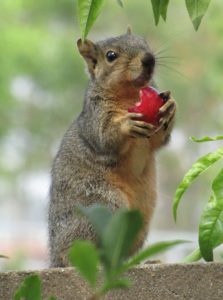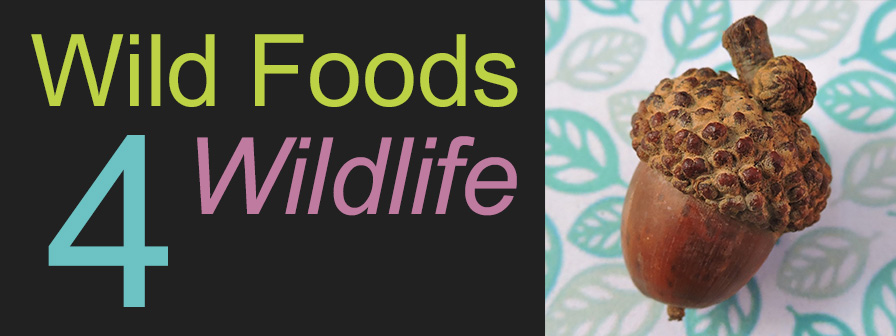
The list below ranks in order the top 75 favorite wildlife foods.
The ranking is determined using two criteria to describe the role of the plant food in animals’ diets:
1) the number of species that utilizes the food,
2) how significant the food is within an individual species overall diet
So while a food may not be popular across a large number of species, it still could be strongly preferred by a few species. By coordinating with a rehabber’s specific needs, a forager can decide which plants to best target for collection.
Be sure to check any item listed below in the database to see if there are any toxicological warnings associated with that plant or part of the plant.
What Criteria is Used for the Ranking the Lists?
| Common Name | Botanical Name | Part Eaten | |
| 1 | blackberry | Rubus spp. | fruit |
| 2 | elderberry | Sambucus spp. | fruit |
| 3 | cherry, wild | Prunus spp. | fruit |
| 4 | blueberry | Vaccinium spp. | fruit |
| 5 | dogwood | Cornus spp. | fruit |
| 6 | grape | Vitis spp. | fruit |
| 7 | smartweed (knotweed) | Polygonum spp. | seeds |
| 8 | corn | Zea mays | agricultural grain |
| 9 | mulberry | Morus spp. | fruit |
| 10 | oak | Quercus spp. | nuts |
| 11 | ragweed | Ambrosia spp. | seeds |
| 12 | pokeweed | Phytolacca americana | fruit |
| 13 | serviceberry | Amelanchier spp. | fruit |
| 14 | sedge | Carex spp. | seeds |
| 15 | millet, wild | Echinochloa spp. | seeds |
| 16 | sumac | Rhus spp. | fruit |
| 17 | pine | Pinus spp. | seeds |
| 18 | panicgrass | Panicum spp. | seeds |
| 19 | juniper | Juniperus spp. | fruit |
| 20 | bristlegrass | Setaria spp. | seeds |
| 21 | wheat | Triticum spp. | agricultural grain |
| 22 | Virginia creeper | Parthenocissus spp. | fruit |
| 23 | crabapple/ apple | Malus spp. | fruit |
| 24 | poison ivy, eastern | Toxicodendron radicans | fruit |
| 25 | bayberry (waxmyrtle) | Myrica spp. | fruit |
| 26 | olives | Elaeagnus spp. | fruit |
| 27 | bulrush | Scirpus spp. | seeds |
| 28 | gum | Nyssa spp. | fruit |
| 29 | oats | Avena spp. | agricultural grain |
| 30 | gum, black (black tupelo) | Nyssa sylvatica | fruit |
| 31 | viburnum | Viburnum spp. | fruit |
| 32 | holly | Ilex spp. | fruit |
| 33 | beech, American | Fagus grandifolia | nuts |
| 34 | redcedar, eastern | Juniperus virginiana | fruit |
| 35 | strawberry | Fragaria spp. | fruit |
| 36 | rose | Rosa spp. | fruit |
| 37 | birch | Betula spp. | seeds |
| 38 | oak, northern red | Quercus rubra | nuts |
| 39 | sunflower | Helianthus spp. | seeds |
| 40 | switchgrass | Panicum virgatum | seeds |
| 41 | greenbrier | Smilax spp. | fruit |
| 42 | honeysuckle, bush | Lonicera spp. | fruit |
| 43 | huckleberry | Gaylussacia spp. | fruit |
| 44 | elm | Ulmus spp. | seeds |
| 45 | olive, autumn | Elaeagnus umbellata | fruit |
| 46 | nightshade | Solanum spp. | fruit |
| 47 | spruce | Picea spp. | seeds |
| 48 | hickory | Carya spp. | nuts |
| 49 | widgeongrass | Ruppia maritima | aquatic greens |
| 50 | maple | Acer spp. | seeds |
| 51 | dock | Rumex spp. | seeds |
| 52 | mountain ash | Sorbus spp. | fruit |
| 53 | hawthorn | Crataegus spp. | fruit |
| 54 | pondweed | Potamogeton spp. | seeds |
| 55 | dogwood, flowering | Cornus florida | fruit |
| 56 | sassafras | Sassafras albidum | fruit |
| 57 | widgeongrass | Ruppia maritima | seeds |
| 58 | pigweed (amaranth) | Amaranthus spp. | seeds |
| 59 | lingonberry | Vaccinium vitis-idaea | fruit |
| 60 | hackberry | Celtis spp. | fruit |
| 61 | oak, chinkapin | Quercus muehlenbergii | nuts |
| 62 | bluegrass | Poa spp. | seeds |
| 63 | walnut | Juglans spp. | nuts |
| 64 | sweetgum | Liquidamber styraciflua | seeds |
| 65 | pondweed | Potamogeton spp. | aquatic greens |
| 66 | wild rice | Zizania spp. | seeds |
| 67 | crabgrass | Digitaria spp. | seeds |
| 68 | persimmon, common | Diospyros virginiana | fruit |
| 69 | clover | Trifolium spp. | seeds |
| 70 | spikerush | Eleocharis spp. | seeds |
| 71 | winterberry, common | Ilex verticillata | fruit |
| 72 | mulberry, red | Morus rubra | fruit |
| 73 | hemlock | Tsuga spp. | seeds |
| 74 | muskgrass | Chara spp. | aquatic greens |
| 75 | chickweed, common | Stellaria media | seeds |
The main resources used to build this website usually rated foods in three levels of preference: high, middle and low. But, a plant may be high preference in Michigan but lower preference in Virginia. So the preference factor has some built in limitations. Still, it is factor #1 in the algorithm.
The second factor considered was how many species of animals ate the part of the plant in consideration. A seed that 29 species ate would outrank a seed that only 5 species ate.
From a foragers perspective, it would be ideal to collect the most highly preferable foods that feed the widest range of rehabilitation animals, right? Well maybe not.
Consider if a rehabilitator only works with foxes? To research which foods would be most beneficial in the “fox only” scenario, the only consideration that she would care about is the most preferred food for foxes, not how many other species ate it.
So the ranking lists are the most general broad interpretation of the data. You will want to generate your own lists from the search feature to find out just what you want to target for collection.
References Used with Permission:
The Fire Effects Information System, U.S. Department of Agriculture, Forest Service, Rocky Mountain Research Station, Fire Sciences Laboratory (Producer).
Fire Effects Information System (2017) Plant species ecology literature reviews. Retrieved various dates from https://www.feis-crs.org/feis/
Martin, A.C., Zim, H.S., Nelson, A.L. (1951). American Wildlife and Plants: A Guide to Wildlife Food Habits. New York: Dover Publications.
Scott, M. (2013). Songbird Diet Index. National Wildlife Rehabilitators Association, St. Cloud, MN.
